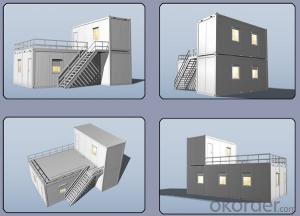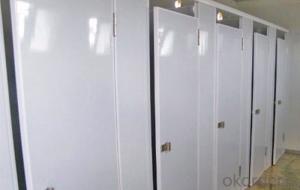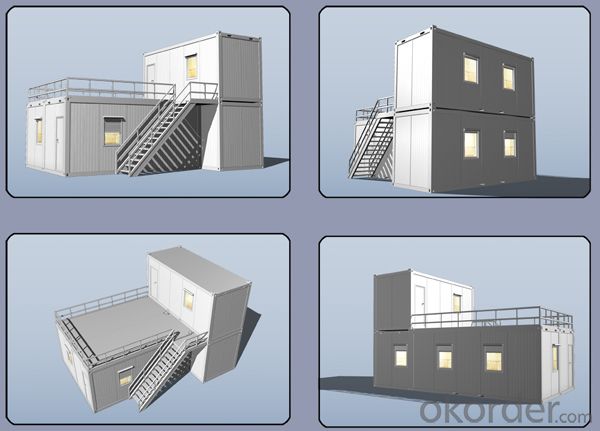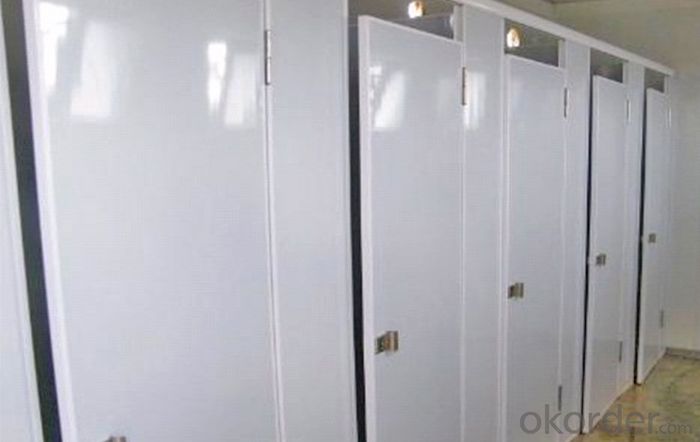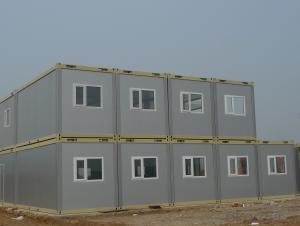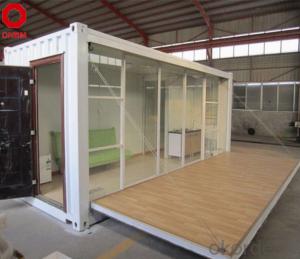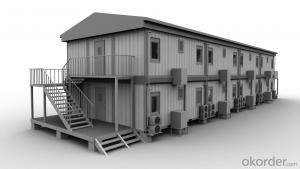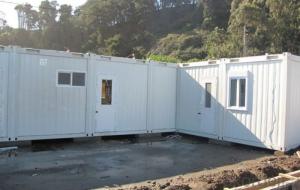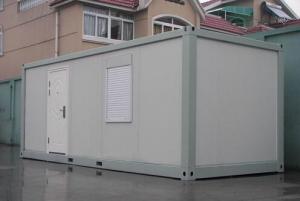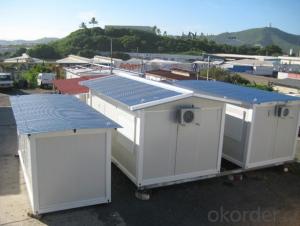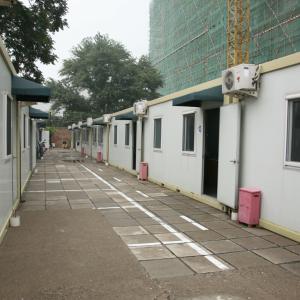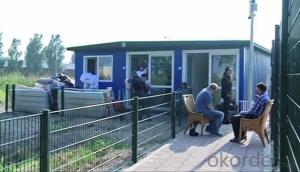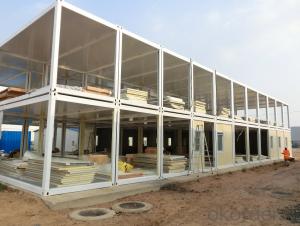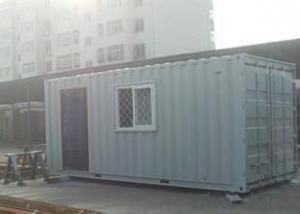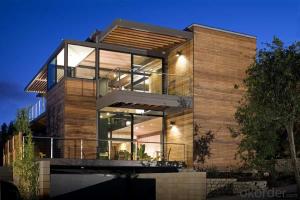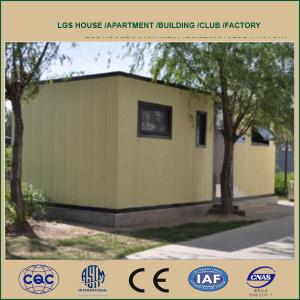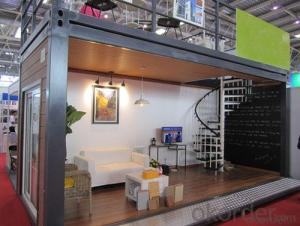Container House , 20ft container house, Mobile house
- Loading Port:
- Shanghai
- Payment Terms:
- TT OR LC
- Min Order Qty:
- 4 set
- Supply Capability:
- 200 set/month
OKorder Service Pledge
OKorder Financial Service
You Might Also Like
Specification
Container House
Easy Transportation, Fast Construction, Flexible Combination, Cost Saving, Green&Sustainable
The units are suitable for:
• Accommodation units • Office / Hotel • Large Camps
• Temporary Housing • Exhibitions • Construction sites
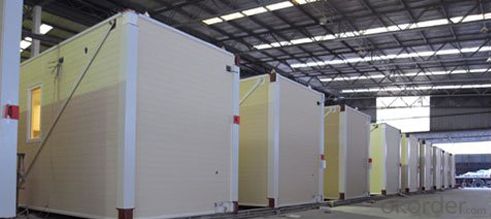
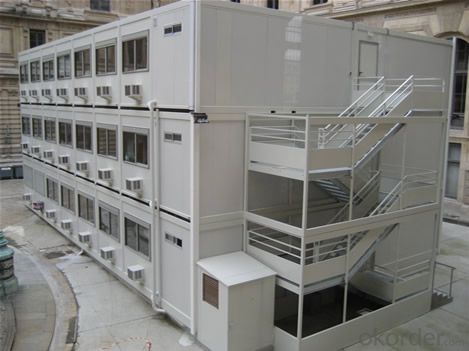
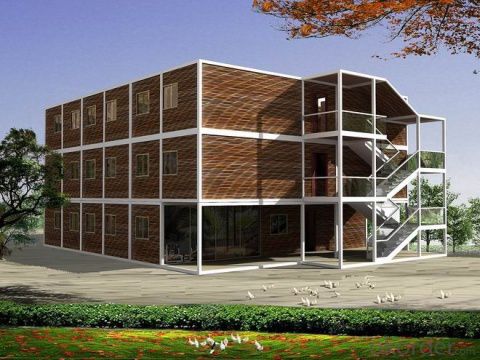
1. The benefits of Container House
Perfect for modular/prefab site offices,cabins,warehouse,villa,toliet,shop,hotel,camp,office
Efficient, low cost designs that can be customized for end user requirements
Easy for low skilled workers to assemble
The light steel frame structure is strong and reliable
Many modular homes can be stacked and linked together to create more space
Neat inside: plumbing and wires are hidden into the sandwich panel
2. Certificates:
ISO9001, ISO14001, CSA(Canadian Standards Association)
3. Specification:
Frame
.Cold formed 3-4mm Steel Profile
. Wind resistance capacity>120km/h,
. Seismic resistance capacity > grade 8
Floor
·0.4 mm flat galvanized steel sheet
·50mm non combustible mineral wool
·18mmplywood panel
·Customized PVC floor
Roof
.0.5mm galvanized &painted steel sheet
·50mm non combustible mineral wool
·50mm Sandwich panel
·one set CE electronic installation
Door
·Single fold, 40mm thick
·Insulated with PL (polystyrene)
·Opening dimensions of 808×2030mm, with a handle lock with 3 keys.
·Net opening dimensions: 754 x 1985 mm.
Wall Panel
60mm EPS /PU/Rock wool Sandwich panel
Window
·Made of PVC, white color, with dimensions 800×1100mm,
glazed with double layer glass with sliding mechanism (one side fixed
and one sliding).
More extra types chosen in term of your specific needs.
4.The cabin can be dis-assemebled for transport.
4 units/bundle, the bundle is the same dimension as 20'GP container .

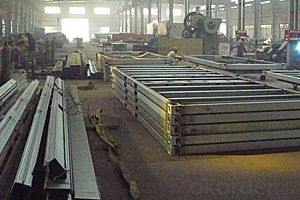
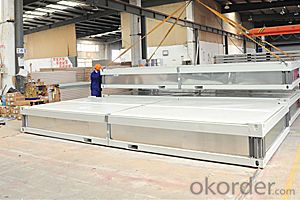
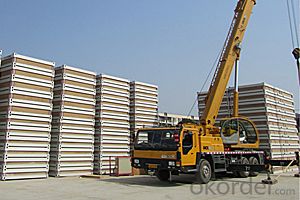
- Q: Can container houses be built with multiple stories?
- Indeed, it is possible to construct container houses with multiple stories. Although shipping containers are typically employed for single-story buildings, they can also be stacked or merged to form multi-story container houses. This not only enhances flexibility but also maximizes the utilization of limited space. Nonetheless, it is crucial to take into account structural integrity and proper engineering in the design of multi-story container houses in order to guarantee the safety and stability of the edifice. Moreover, additional adjustments and reinforcements may be necessary to comply with building codes and regulations.
- Q: Are container houses suitable for remote or wilderness retreats?
- Yes, container houses are suitable for remote or wilderness retreats. These types of houses are highly versatile and can be designed to cater to various needs and environments. The durability and mobility of container houses make them ideal for remote locations where traditional construction may be difficult or costly. Container houses are made from strong steel structures designed to withstand harsh weather conditions, making them resilient in remote or wilderness areas that may experience extreme temperatures, high winds, or heavy snowfall. They are also built to be transportable, allowing them to be easily shipped to and assembled in remote locations without the need for extensive infrastructure or heavy machinery. Additionally, container houses can be customized to blend seamlessly with the natural surroundings, ensuring minimal impact on the environment. They can be designed with large windows to maximize natural light and provide stunning views of the wilderness. Moreover, container houses can be equipped with sustainable features such as solar panels, rainwater harvesting systems, and composting toilets, making them eco-friendly and self-sufficient in remote locations. Furthermore, container houses offer flexibility in terms of size and layout. They can be expanded or reconfigured to accommodate different needs, whether it be a small cabin for a solitary retreat or a larger structure for group gatherings. The modular nature of container houses also allows for easy additions or modifications as required. Overall, container houses provide an excellent solution for remote or wilderness retreats. They offer durability, mobility, and versatility while minimizing environmental impact. With their ability to withstand rugged conditions and blend with the natural surroundings, container houses provide a comfortable and sustainable living space for those seeking solace and tranquility in remote locations.
- Q: What are the disadvantages of living in a container house?
- Living in a container house has its fair share of drawbacks. One primary disadvantage is the limited space within the container. Originally designed for shipping, containers are typically small and cramped, posing a challenge for individuals or families in need of more living area. This can make furniture arrangement and storage difficult, requiring creative use of available space. Furthermore, container houses may lack proper insulation, resulting in extreme temperatures indoors. In hot summer months, the containers can become unbearably hot, necessitating additional cooling systems. Conversely, during colder seasons, the lack of insulation makes it challenging to maintain a comfortable indoor temperature, requiring extra heating sources. Another drawback is the limited natural light that enters the container. Small windows make the space feel dark and gloomy. This lack of natural light can negatively affect mood and productivity, often requiring artificial lighting throughout the day. Privacy can also be a concern in container houses. Due to their design, containers offer limited soundproofing capabilities, allowing noise from outside or neighboring containers to easily penetrate the living space. This lack of privacy can be a significant drawback for those who value a peaceful living environment. Moreover, obtaining permits and meeting building regulations can be a more arduous task for container houses. Areas often have strict zoning laws and building codes that may not align easily with container housing. This can lead to a longer and more complex process to gain necessary approvals, potentially resulting in delays and higher costs. Lastly, the resale value of container houses may be lower compared to traditional houses. As container houses are still relatively new and unconventional, there may be less demand from potential buyers. This can make it challenging to recoup the initial investment or make a profit if the property is sold in the future. In conclusion, container houses offer unique and environmentally friendly living options, but they come with their fair share of drawbacks, including limited space, insulation issues, lack of natural light, privacy concerns, challenges in obtaining permits, and potentially lower resale value. It is crucial to carefully consider these disadvantages before deciding to live in a container house.
- Q: Are container houses suitable for military or temporary base housing?
- Yes, container houses can be suitable for military or temporary base housing. Container houses offer several advantages that make them a viable option for such purposes. Firstly, container houses are highly durable and sturdy. They are designed to withstand extreme weather conditions, making them suitable for military bases that might be located in challenging environments. They are also built to be resistant to fire and other hazards, providing a safe living environment for military personnel. Secondly, container houses are portable and easy to transport. They can be quickly and efficiently moved from one location to another, which is especially beneficial for temporary base housing. This flexibility allows military bases to adapt to changing needs and relocate housing units as required. Additionally, container houses are cost-effective. They are significantly cheaper than traditional construction methods, allowing military organizations to save on construction and maintenance costs. This cost-effectiveness is particularly important for temporary bases, where budget constraints are often a concern. Furthermore, container houses can be customized and modified to meet specific requirements. They can be easily expanded or connected to create larger living spaces, accommodating different numbers of personnel. They can also be equipped with necessary amenities such as heating, cooling, plumbing, and electrical systems, ensuring that military personnel have all the necessary comforts. Lastly, container houses are environmentally friendly. By repurposing shipping containers, we can reduce waste and promote sustainability. They can be designed to be energy-efficient, incorporating insulation and renewable energy sources, further reducing their carbon footprint. In conclusion, container houses are suitable for military or temporary base housing due to their durability, portability, cost-effectiveness, customizability, and environmental friendliness. They provide a practical and efficient solution for accommodating military personnel in various locations and situations.
- Q: Are container houses waterproof?
- Yes, container houses can be made waterproof. When converting shipping containers into homes, proper insulation and sealing techniques are used to ensure that they are fully waterproof. This involves reinforcing the container's roof, walls, and floors with additional layers such as insulation, waterproof membranes, and weather-resistant coatings. Additionally, windows and doors are properly sealed to prevent any water leakage. With the right construction methods and materials, container houses can withstand heavy rain, storms, and other weather conditions, ensuring that they remain dry and protected from water damage.
- Q: Can container houses have multiple stories?
- Container houses are not restricted to single levels, contrary to what many people believe. It is possible to stack containers on top of each other to form multiple stories, as long as the appropriate design and structural modifications are made. By reinforcing the containers with extra steel beams and columns, a stable and secure structure can be created, capable of supporting multiple levels. Furthermore, container homes can also be expanded horizontally by adding more containers next to each other. This adaptability enables the construction of container houses with multiple stories, offering increased living space and meeting the requirements of larger families or diverse needs.
- Q: Are container houses suitable for artists or creative professionals?
- Artists or creative professionals can definitely find container houses suitable. The versatility and adaptability of container houses are among their biggest advantages, which can be particularly appealing to those in the creative field. Artists can customize and design these houses to meet their specific artistic needs, creating their own unique and inspiring living spaces. Container houses provide a wide range of design possibilities. The modular nature of containers allows for easy expansion and modification, giving artists the freedom to create a space that suits their artistic requirements. They can transform these houses into spacious studios with ample natural light, providing an ideal environment for painters, sculptors, or any other type of artist. Furthermore, container houses can also have specific storage solutions for art supplies, materials, or even gallery spaces to showcase their work. Additionally, container houses are often more affordable than traditional houses or studios, making them an attractive option for artists or creative professionals on a tight budget. These houses can be built relatively quickly and at a fraction of the cost of a conventional home, allowing artists to invest more in their creative endeavors. Furthermore, container houses are environmentally friendly. By repurposing old shipping containers, they reduce waste and become an eco-conscious choice for artists concerned about sustainability. The use of recycled materials can also add a unique aesthetic appeal to the living space, further enhancing the artistic atmosphere. However, it is important to note that container houses may not be suitable for every artist or creative professional. Some artists may require larger or more specific spaces that cannot be easily accommodated by container houses. Additionally, those who value traditional architectural features or historical buildings may not find container houses aesthetically appealing. In conclusion, container houses can be a great option for artists or creative professionals seeking a unique, customizable, and cost-effective living space. These houses offer endless possibilities for artistic expression and can be tailored to meet the specific needs of each individual artist.
- Q: What are the advantages of living in a container house?
- There are several advantages of living in a container house that make it an appealing option for many individuals. Firstly, container houses are incredibly cost-effective. Buying a shipping container and converting it into a livable space is significantly cheaper than purchasing or building a traditional house. This affordability allows individuals to save money or allocate their funds to other important aspects of their lives. Secondly, container houses are highly versatile and can be customized to suit individual needs and preferences. With some creativity and design expertise, containers can be transformed into comfortable and stylish living spaces. They can be customized to include various amenities such as windows, doors, insulation, electricity, plumbing, and even multiple stories. The ability to customize container houses provides individuals with the opportunity to create a unique and personalized living environment. Another advantage of container houses is their portability. Shipping containers are designed to be transported easily, making it possible to relocate your home if needed. This mobility is particularly beneficial for individuals who value flexibility and enjoy changing their living environment, such as frequent travelers or those who move frequently due to work or personal reasons. Furthermore, container houses are environmentally-friendly. By repurposing shipping containers, we reduce the demand for new construction materials, minimize waste, and contribute to sustainable living. Additionally, container homes can be designed to be energy-efficient, utilizing renewable energy sources and incorporating eco-friendly practices such as rainwater harvesting. Lastly, container houses are relatively quick to construct. Compared to traditional housing, which often takes several months or even years to build, container homes can be completed in a shorter period of time. The modular nature of containers allows for faster construction, reducing labor and material costs. In conclusion, living in a container house offers several advantages including affordability, customization, portability, sustainability, and faster construction. These benefits make container houses an attractive and viable housing option for those seeking a unique, cost-effective, and environmentally-conscious living experience.
- Q: Can container houses be designed with a separate office space?
- Certainly, container houses have the potential to incorporate a distinct office space. One of the remarkable benefits of container houses lies in their adaptability and modularity, which allows for versatile designs and setups. By engaging in meticulous planning and design, it becomes feasible to integrate a separate office area within a container house. The establishment of an office space can be achieved through the division of the container into distinct sections or by utilizing multiple containers to construct separate rooms. The dimensions and arrangement of the office area can be tailored to meet individual requirements and preferences. For instance, a larger container can be exclusively designated for office purposes, or a smaller section within the container can be allocated as an office zone. To ensure practicality, it is essential to consider factors like proper insulation, ventilation, lighting, and soundproofing when designing the office space. This will contribute to the creation of a comfortable and conducive work environment within the container house. Moreover, container houses can be enhanced with additional features and amenities to elevate the office space. These additions may encompass windows to maximize natural light, integrated storage solutions, electrical outlets, internet connectivity, and ergonomic furniture. In conclusion, container houses undeniably have the potential to incorporate a separate office space. With careful planning and design, it is possible to establish a functional and comfortable office environment within a container house. This provides a flexible and cost-effective solution for individuals seeking a home-office setup.
- Q: Can container houses be designed to have a children's play area?
- Yes, container houses can definitely be designed to have a children's play area. By utilizing the available space creatively and incorporating child-friendly elements, such as safe flooring, colorful walls, and age-appropriate play equipment, container houses can easily accommodate a designated play area for children.
Send your message to us
Container House , 20ft container house, Mobile house
- Loading Port:
- Shanghai
- Payment Terms:
- TT OR LC
- Min Order Qty:
- 4 set
- Supply Capability:
- 200 set/month
OKorder Service Pledge
OKorder Financial Service
Similar products
Hot products
Hot Searches
Related keywords
